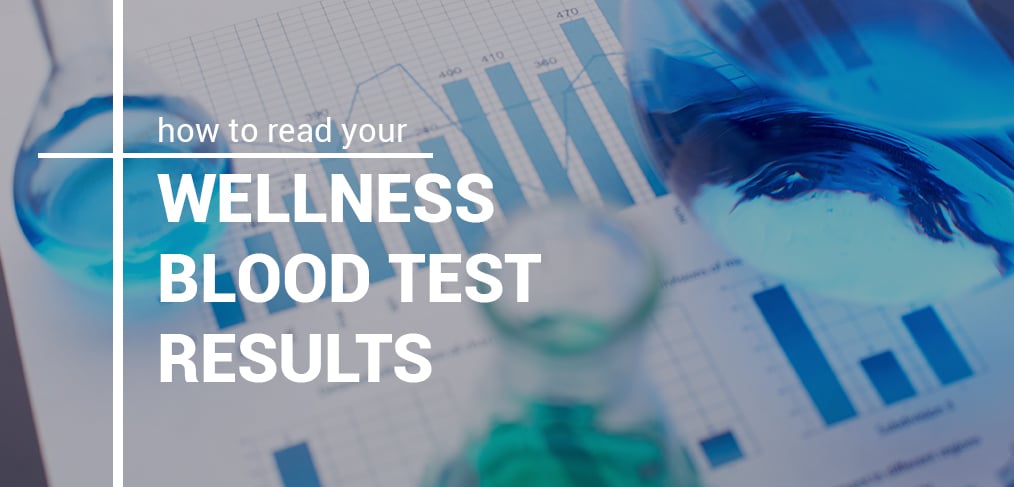
How To Read Your Wellness Blood Test Results
A wellness panel takes a look at your overall health and helps you evaluate your organs and systems like the thyroid, liver, kidneys and immunity. And because there is so much valuable information, it’s obviously important for you to understand how to read your blood test results. But you are probably asking yourself, what do my blood test results mean?
Below is a handy guide to decoding a sampling of your blood test results.
Learn To Read Your Wellness Blood Test Results!
1. The urea nitrogen BUN test is used to evaluate kidney function. The test measures levels of urea or nitrogen in your urine.
Understanding lab test results…
- In general, normal BUN levels range from 6-20 (mg/dL) in adults.
- Higher BUN levels can indicate dehydration, kidney failure or disease, high protein levels, heart failure, gastrointestinal bleeding, or obstruction in the urinary tract.
- Lower BUN levels can indicate liver failure, malnutrition or severe lack of protein in your diet.
So, if you find yourself with a number over 21, check with your doctor about the possibility of the first set of diseases. And if it’s under 6, check about the second set of diseases.
2. The total protein test measures how much of the proteins albumin and globulin are in your body.
Understanding your blood test results when it comes to protein…
- The normal range for total protein is between 6 and 8.3 (g/dL).
- High protein could mean inflammation or infections, such as viral hepatitis B or C, or HIV. It can also be an indicator of bone marrow disorders.
- Low protein could indicate bleeding, liver disorder, kidney disorder, malnutrition, or inflammatory conditions.
Bet you didn’t even think you could have higher or lower levels of protein. Now, you know what it means when you don’t get enough or have too much.
3. The sodium serum test measures the amount of sodium in your blood.
- The normal range for sodium levels is 136-145 (mmol/L).
- High sodium could mean that you are dehydrated, not drinking enough water and eating too much sodium in your diet. Low sodium could be a symptom of under active adrenal glands, kidney failure, heart failure or thyroid gland.
- Low sodium can also be caused by sweating, burns, diarrhea or poor nutrition.
There’s so much hidden sodium in food. This is really easy to overdo!
4. Cholesterol total test measures the amount of the waxy, fat-like Cholesterol in your blood. The cholesterol total test will look at both LDL (bad) and HDL (good) cholesterol.
- The normal range for overall cholesterol is less than 200 (mg/dL).
- High total cholesterol is 240 (mg/dL) and above and is considered risky.
- And borderline high risk is in a range of (200-239 mg/dL)
Not all cholesterol is bad for you. Make sure you get enough of the good kind (HDL).
5. The calcium test measures the amount of calcium in your body that is not stored in your bones.
- The normal range for calcium levels is 8.8-10.4 (mg/dL).
- High calcium might be caused by long term bed rest after a broken bone, hyperparathyroidism, cancer, Paget’s disease, and tuberculosis.
- Low calcium might occur from a low level of the blood protein albumin, hypoparathyroidism, high levels of phosphate in the blood, rickets, and malnutrition from celiac disease, pancreatitis, and alcoholism.
Calcium isn’t just about having strong bones, although that IS an important part!
6. A Urinalysis complete test detects abnormalities in the urine. Problems with your lungs, urinary tract, skin, kidneys and bladder can all be detected by testing your urine.
- High protein, presence of crystals, infectious bacteria or yeast, epithelial cells, sugar, blood, pH levels or acidity and abnormalities in red or white blood cells, are all indications of disease that can be detected through urinalysis.
- Normal urine basically is the absence of the above…there should be no protein, yeast, bacteria, ketones or glucose and very few red or white blood cells and crystals. The normal pH for your urine is 6.
7. The thyroid panel indicates the health of your thyroid gland. It tests the level of TSH in your blood and tells you whether your thyroid is overactive or under active.
The normal TSH range is 0.4 – 4.0 (mIU/L).
- A high TSH level, above (2.0 mIU/L), indicates an under active thyroid gland and causes health problems like weight gain, brittle hair and nails, joint pain, infertility, depression and heart disease.
- A low TSH level indicates an overactive thyroid gland that produces too much thyroid hormone.
- You might experience weight loss, high levels of anxiety or tremors.
If your levels are too high or too low means the difference in being hypothyroid and hyperthyroid. Treatments vary for both despite each being a thyroid disease.
8. The complete blood count, or CBC test, looks at the red blood cells, white blood cells and platelets.
A normal CBC consists of white, red, platelet, hematocrit and hemoglobin counts.
And the blood test results…
- Normal for red blood cell count: 3.90-5.72 trillion cells/L
- Normal for white blood cell count: 3.5-10.5 billion cells/L
- Normal for platelet count: 150-450 billion/L
- Normal for hemoglobin: 12.0-17.5 grams/dL
- Normal for hematocrit: 34.9-50.0 percent
- If your red blood count, including hemoglobin and hematocrit, is low, you are likely anemic.
- If the same red blood count is high, you could have heart disease. Causes of high red blood count are smoking, kidney disease, heart disease, alcoholism and liver disease.
- A high white blood cell count can indicate inflammation, infection or immune disorder.
- A low white blood cell count can be caused by autoimmune disorders, cancer, or bone marrow problems.
The CBC is an extremely useful test that provides your doctor a lot of information regarding your health.
9. The vitamin D 25-hydroxy test measures how much vitamin D is in your body.
- The normal range for vitamin D is between 20 and 40 (ng/mL).
- High vitamin D may be due to too much vitamin D and a condition called hypervitaminosis D which can lead to symptoms of kidney damage.
- Low vitamin D can happen with liver and kidney disease, lack of vitamin D in the diet, lack of exposure to sunlight, poor food absorption and use of certain medicines.
Most people suffer from a lack of Vitamin D, which is a shame because you can get it from simply going outside more. Order a vitamin, mineral, or nutrition test
10. The folate or folic acid test measures the amount of folic acid in the body; one of many forms of vitamin B.
- The normal range for folic acid in the blood is is between 2.7 and 17.0 (ng/mL).
- Higher-than-normal folic acid levels usually aren’t problematic, but they might indicate a vitamin B-12 deficiency.
- A lower level of folic acid might indicate anemia, malabsorption or problems absorbing vitamins and minerals or just a folic acid deficiency.
Now that you have a better understanding of what you’ll see from your results, you can take bigger control over your healthcare. Get your Wellness Test today!
If you seek additional information regarding test results, you may choose to visit Lab Tests Online, a public resource for clinical lab testing and an excellent resource.
Though Walk-In Lab’s Medical Director reviews all lab results, testing through Walk-In Lab does not replace the need for your primary care physician. Walk-In Lab testing is intended for information and education, and not diagnostic purposes. When you order an online blood test, you should follow up with your physician to review your laboratory results, especially those which are flagged in the out-of-normal reference range.



